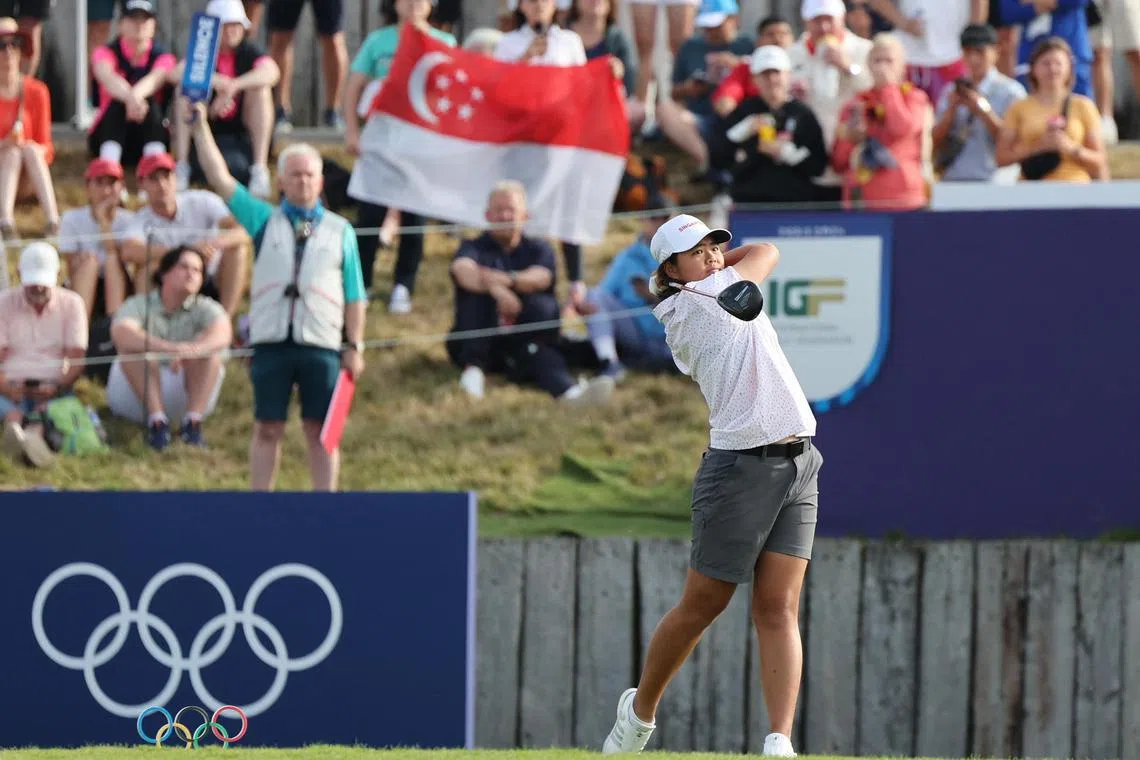Qualifying two female golfers for the Olympics by 2032 among efforts to grow the women’s game in S’pore
Sign up now: Get ST's newsletters delivered to your inbox

Shannon Tan has blazed a trail by becoming the first Singaporean golfer to qualify for the Olympics.
PHOTO: REUTERS
Follow topic:
SINGAPORE – Plans are in place to grow women’s golf in Singapore with the aim of getting more players into the next two Olympics as the fraternity seek to ride on the momentum of a milestone year by Shannon Tan.
The 20-year-old made history as the first Singaporean to win on the Ladies European Tour (LET) and qualify for the Olympics.
She also became the first female golfer to feature in the Majors when she played at the prestigious Evian Championship and made the cut at the Women’s British Open.
Buoyed by the achievement, the Singapore Golf Association (SGA) and the Singapore Ladies Golf Association (SLGA) set out several goals, including having two women’s golfers qualify for the 2028 and/or 2032 Olympics when they reaffirmed their commitment to The Royal & Ancient’s (R&A) Women in Golf Charter in late September.
SLGA president Gillian Sim said: “We want to see (Singapore) golf out there in the world rankings, we want to encourage our girls.
“I’m very passionate about promoting the game of golf to young kids such that we have more Olympians, ladies playing on tours like the LET.
“We only have one Shannon playing, I want to have more Singaporeans... Look at the Thais, look at the Filipinos, the Koreans.
“Myself and (SGA president Tan) Chong Huat want to see Singapore out there, our girls doing well and using golf as a way to earn a living as well. I just want to elevate the game of golf in Singapore.”
A key part of the SLGA and SGA’s efforts to get another golfer on the world stage is by increasing the number of opportunities for local players to compete overseas and move up the rankings.
The SGA will be staging fund-raising initiatives to enable the golfers to play in top amateur tournaments overseas and get used to different playing conditions.
Another aim is to increase the number of female golfers listed on the World Amateur Golf Ranking by 20 per cent – from 18 currently to 23 – within three years.
Sim said: “We want to give opportunities to our kids to play all these events and help them gain the experience to actually go up a different level and the professional level.”
Pointing to the regular junior tournaments being held to unearth talent, she said those selected will go through a structured development from junior to national level.
Getting more people involved in the sport, especially at the grassroots level, is another area the SGA and SLGA are looking at, with Sim hoping to convince all 11 clubs in Singapore to sign the charter, which pledges to contribute to developing women’s golf.
So far, only the Singapore Island Country Club and Seletar Country Club have done so – Seletar will be holding a Seletar Ladies Open and having more junior programmes to encourage children, especially girls, to pick up the sport.
The two bodies want to boost the number of women registered in the SGA Centralised Handicapping System from 8,000 to 9,200, a hike of 15 per cent.
They are also aiming to increase the proportion of junior female golfers participating in SGA junior activities from 30 per cent to 40 per cent over the next three years.
Noting the limited golf facilities in Singapore, Sim shared that they are exploring alternatives, such as indoor simulators, to promote the sport, with the SGA working to collaborate with NTUC, which is setting up a golf simulator in Downtown East.
Tan said: “Golf is an inclusive sport and we certainly want to encourage and support more women to play and excel in the sport. The R&A’s Women in Golf Charter provides that additional platform for us to achieve that objective and we are delighted to be working closely with the SLGA to do that.”
Shannon is encouraged by these plans, calling it a positive move.
She said: “A strong ecosystem which encourages grassroots golf is key, and if the SGA and SLGA commitment can increase the number of players coming through, then there will be a pipeline of talent to benefit from the high-performance initiatives.
“This can only help to promote the game and help to uncover the next generation of talent in Singapore golf.”
Correction note: In an earlier version of the story, we said that the SLGA is working with NTUC. This is incorrect. It should be the SGA.

